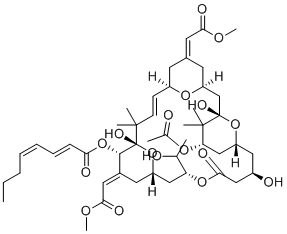
Bryostatin 1
CAS No. 83314-01-6
Bryostatin 1( NSC 339555 | Bryostatin1 )
Catalog No. M16088 CAS No. 83314-01-6
Bryostatin 1 (NSC 339555) is a macrocyclic lactone derived from a marine invertebrate, fuctions as an activator of PKC with high binding affinity (Ki=1.35 nM).
Purity : >98% (HPLC)
 COA
COA
 Datasheet
Datasheet
 HNMR
HNMR
 HPLC
HPLC
 MSDS
MSDS
 Handing Instructions
Handing Instructions
| Size | Price / USD | Stock | Quantity |
| 100MG | Get Quote | Get Quote |


|
| 200MG | Get Quote | Get Quote |


|
| 500MG | Get Quote | Get Quote |


|
| 1G | Get Quote | Get Quote |


|
Biological Information
-
Product NameBryostatin 1
-
NoteResearch use only, not for human use.
-
Brief DescriptionBryostatin 1 (NSC 339555) is a macrocyclic lactone derived from a marine invertebrate, fuctions as an activator of PKC with high binding affinity (Ki=1.35 nM).
-
DescriptionBryostatin 1 (NSC 339555) is a macrocyclic lactone derived from a marine invertebrate, fuctions as an activator of PKC with high binding affinity (Ki=1.35 nM); functions like the phorbol esters biochemically in binding to and activating protein kinase C; inhibits tumor promotion by phorbol esters in SENCAR mouse skin, induces differentiation of B-chronic lymphocytic leukemia cells; blocks phorbol ester action in Friend cells, restores the differentiation respons with EC50 of 15 nM.Alzheimer Disease Phase 2 Clinical.
-
In VitroBryostatin 1 (1 μM; 5 minutes; HT22 cells) treatment successfully recruits Munc13-1 from the cytosol to the plasma membrane. Effects of Bryostatin 1 on the other Munc13 family members, ubMunc13-2 and bMunc13-2, resembled those of Munc13-1 for translocation .The increased level of expression of Munc13-1 following a 24 h incubation with Bryostatin 1 in both HT22 and primary mouse hippocampal cells is observed.Bryostatin 1 can also affect the immune system by modulating dendritic cells (DCs) via toll-like receptor 4 (TLR4) through the MyD88-independent pathway, which favors an anti-inflammatory environment by inducing a type 2 phenotype that promotes the differentiation of CD4+ T-helper (Th) lymphocytes into Th2 versus Th1 effector cells. Western Blot Analysis Cell Line:HT22 cells Concentration:1 μM Incubation Time:5 minutes Result:Caused Munc13-1 to transfer to the membrane fraction.
-
In VivoBryostatin 1 (30 μg/kg; intraperitoneal injection; 3 d per week; for 2 weeks; C57BL/6J mice) treatment abolishes the onset of EAE. Animal Model:Female C57BL/6J mice (8-12-week-old) with MOG35-55 Dosage:30 μg/kg Administration:Intraperitoneal injection; 3 d per week; for 2 weeks Result:Abolished the onset of experimental autoimmune encephalomyelitis (EAE).
-
SynonymsNSC 339555 | Bryostatin1
-
PathwayAngiogenesis
-
TargetPKC
-
RecptorPKC
-
Research AreaNeurological Disease
-
Indication——
Chemical Information
-
CAS Number83314-01-6
-
Formula Weight905.044
-
Molecular FormulaC47H68O17
-
Purity>98% (HPLC)
-
Solubility——
-
SMILESCCC/C=C/C=C/C(O[C@@H](/C(C[C@@](O1)([H])C[C@H]([C@H](O)C)O2)=C/C(OC)=O)[C@]1(O)C(C)(C)/C=C/[C@@](O3)([H])C/C(C[C@@]3([H])C[C@@](O4)(O)C(C)(C)[C@@H](OC(C)=O)C[C@@]4([H])C[C@@H](O)CC2=O)=C\C(OC)=O)=O
-
Chemical Name2,4-Octadienoic acid, 25-(acetyloxy)-1,11,21-trihydroxy-17-(1-hydroxyethyl)-5,13-bis(2-methoxy-2-oxoethylidene)-10,10,26,26-tetramethyl-19-oxo-18,27,28,29-tetraoxatetracyclo[21.3.1.13,7.111,15]nonacos-8-en-12-yl ester, [1S-[1R*,3R*,5Z,7S*,8E,11R*,12R*(2E,
Shipping & Storage Information
-
Storage(-20℃)
-
ShippingWith Ice Pack
-
Stability≥ 2 years
Reference
1. Wender PA, et al. Proc Natl Acad Sci U S A. 1998 Jun 9;95(12):6624-9.
2. Sako T, et al. Cancer Res. 1987 Oct 15;47(20):5445-50.
3. Dell'Aquila ML, et al. Cancer Res. 1987 Nov 15;47(22):6006-9.
4. Drexler HG, et al. Blood. 1989 Oct;74(5):1747-57.
molnova catalog



related products
-
ζ-Stat
ζ-Stat (1,3,6-Naphthalenetrisulfonic acid) is a novel PKC-zeta (PKC-ζ) specific inhibitor with IC50 of 5 uM.
-
Sotrastaurin
A potent, selective, orally available pan-PKC inhibitor with Ki of 0.22-3.2 nM for PKC isotypes.
-
HG-9-91-01
HG-9-91-01 is a potent and highly selective salt-inducible kinase (SIKs) inhibitor with?IC50s of 0.92 nM, 6.6 nM and 9.6 nM for?SIK1, ?SIK2?and?SIK3respectively.



 Cart
Cart
 sales@molnova.com
sales@molnova.com


